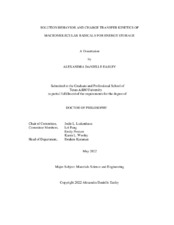| dc.description.abstract | Within a few decades, lithium-ion batteries (LIBs) have revolutionized technologies facilitating the rapid development of new portable devices and electric vehicles. However, this rapid technology growth has exceeded the ability to address issues associated with mining lithium, cobalt, and other mineral ore resources. To reduce this reliance on strategic elements, organic-based electroactive materials have received considerable attention as alternative electrode materials for LIBs. Recently, one class to gain considerable attention is polymers with redox-active groups. One polymer that is popular in literature is poly(TEMPO methacrylate) (PTMA), which has nitroxide radicals that can reversibly store energy through a reduction/oxidation mechanism. Although the investigation of PTMA and fully polymeric batteries is found in literature, there is little consideration for the composite materials, nanostructured fabrication, recyclability of the redox-active polymers, or the anodic polymers redox mechanism. This dissertation focuses on improving the use of redox-active polymers, such as PTMA, in batteries to create safe and recyclable alternatives. Broken into four main objectives and five chapters: (1) design PTMA-based electrodes that exhibit improved performance, (2) fabricate and characterize nanostructured redox-active coatings, (3) use degradable redox-active polymers to improve the recyclability of fully polymeric batteries, and (4) characterize the electron and mass transport of polymers containing viologen groups.
The main findings will be briefly summarized. When designing PTMA-based composite electrodes, identifying materials with similar hydrogen bonding and dispersion Hansen solubility parameters is key to producing electrodes with improved performance. To fabricate nanostructured nitroxide-based thin films, oppositely charged polymers both containing the nitroxide radical should be utilized and the charge of the terminating layer will determine the ion transport mechanism during oxidation and reduction. | |


